You are using an out of date browser. It may not display this or other websites correctly.
You should upgrade or use an alternative browser.
You should upgrade or use an alternative browser.
water lines direct to heads?
- Thread starter PotvinGuy
- Start date
Gerry
Well-Known Member
Anyone tried running water lines directly to heads front face instead of using the manifold, water neck/thermostat, etc? I have seen pics of this, but wonder what are benefits, and how is it done? Drill and tap head for a NPT/AN adapter, or what?
Not sure if this counts as the manifolds have no water ways in them, so its designed to pick up from the front of each head.

Gerry
fordsbyjay
Active Member
Not sure if this counts as the manifolds have no water ways in them, so its designed to pick up from the front of each head.
[attachment=4745:water lines.JPG]
Gerry
Here it is on a boss motor. The only time I have ever seen it done is when your intake doesn't have a water cross over like in Jerry's car. I am not sure why you would want to do it for any other reason.
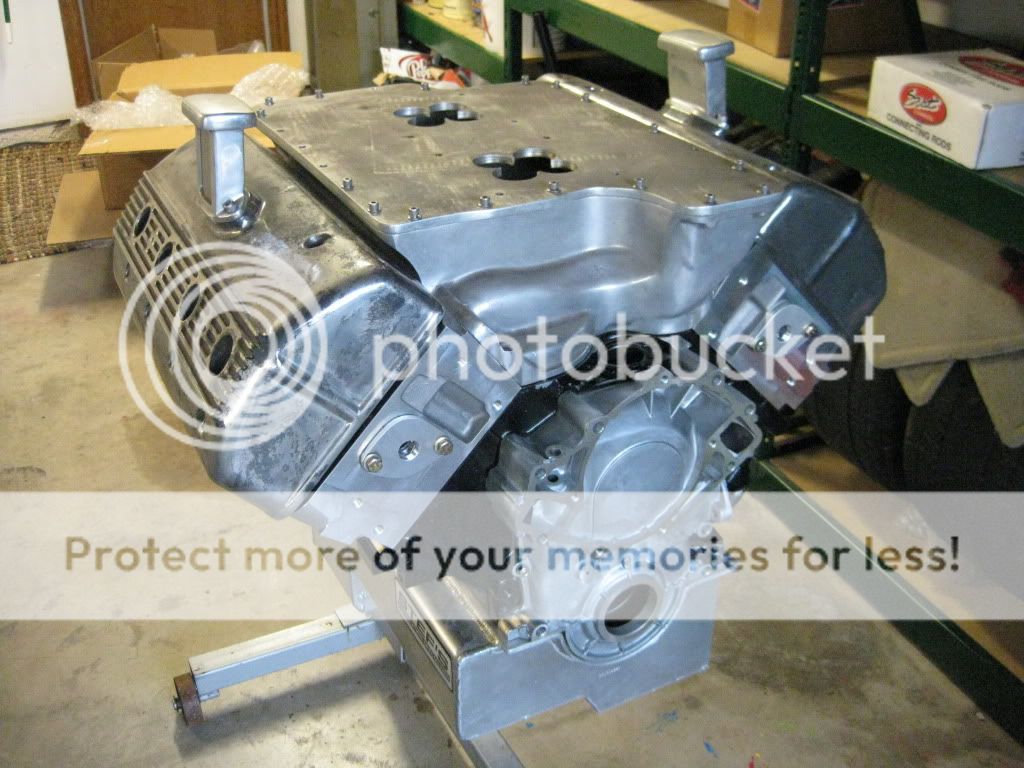
Screaming Metal
Active Member
Theres a slight advantage of flow. its been done alot when running blowers. Usually coming off the top hose into a Tee, on the front of the heads you can layout 2 mounting holes and install a thermostat housing onto each head, Then bore the hole straight into the waterjacket in the front of the heads. Gotta be sure to take a slight skin cut with the mill with a small milling head....that way you won't have a water leak from a unflat surface. I usually run those without the thermostats in them.
OR, you can do it like in the pic in GerryUK's pic there. That way is the easiest. With alot of blowerdrive and boost, I like it on the front of the heads. Also remember, when you make it so alot of coolant can get into the heads, pay attention to the rear of the heads also....most of the time....theres a big bottleneck in flow back there. Things usually have to be stepped up in that dept.
Also remember on blown cars that run hot, if you have a working heater, when your borderline on heat, you can actually turn your heater on and cool down your motor some. Your heater coil itself is a small radiator too....
OR, you can do it like in the pic in GerryUK's pic there. That way is the easiest. With alot of blowerdrive and boost, I like it on the front of the heads. Also remember, when you make it so alot of coolant can get into the heads, pay attention to the rear of the heads also....most of the time....theres a big bottleneck in flow back there. Things usually have to be stepped up in that dept.
Also remember on blown cars that run hot, if you have a working heater, when your borderline on heat, you can actually turn your heater on and cool down your motor some. Your heater coil itself is a small radiator too....
fordsbyjay
Active Member
Theres a slight advantage of flow. its been done alot when running blowers. Usually coming off the top hose into a Tee, on the front of the heads you can layout 2 mounting holes and install a thermostat housing onto each head, Then bore the hole straight into the waterjacket in the front of the heads. Gotta be sure to take a slight skin cut with the mill with a small milling head....that way you won't have a water leak from a unflat surface. I usually run those without the thermostats in them.
Do you have any pics?
Screaming Metal
Active Member
Yes I have pics, Now, can I post them here...I ought to be able to but the computer gods seem not to want me to. I tried posting things here... articles, can't even do that unless I copy and paste.Do you have any pics?
Well, alotof my pics I can't post because of some folks got their names on things sitting around the shop, but I've tried on my own personalstuff and it won't post for some reason. :alarm:
Funny, I can throw together a 4 or 5000 Horse blown drag motor, no problem, but this computer mess has got me all fouled up.
I spent a alldayer/allnighter in the shop yesterday, gonna go climb back into bed for awhile.
Remember, on a motor the coolant enters the waterpump, circulated thru your block and heads, then sits up in your intake, waiting for the thermo to open to circulate the heated coolant thru the radiator. On a high horse motor, your cooking those front cylinders, because all the heat fron your whole motor is being pumped right past them.....
Here's a pic of one setup, appears to use adapter screwed right into head. My interest: my blower manifold doesn't have a water neck, just NPT at each corner, so I run two small hoses from it to radiator. I'm redoing the induction, and want to move the water lines to the heads for less restriction and cleaner look. And I'm going to try reverse flow: cooled water goes to heads first, then thru the block and back. This lowers temp at combustion chambers, thereby reducing chances of steam pockets, boilover and detonation. Will have air bleeds at top rear of heads to burp system. Just a tweak, but I do like to experiment.
Attachments
Bill Pedersen
Member
Here are a few pictures of a really nice car from Colorado that I took at the KC Goodguys show.
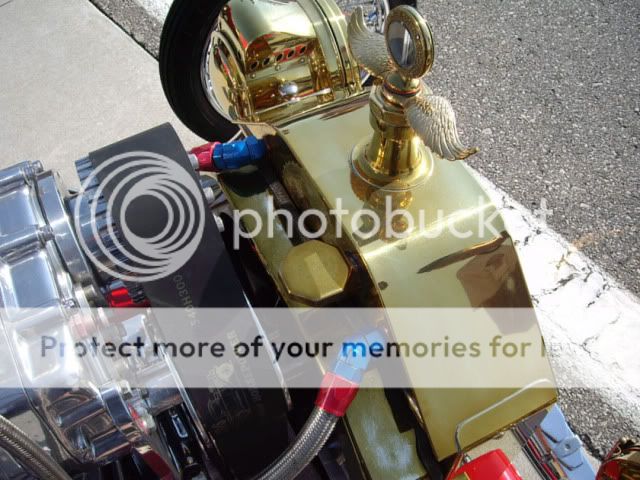
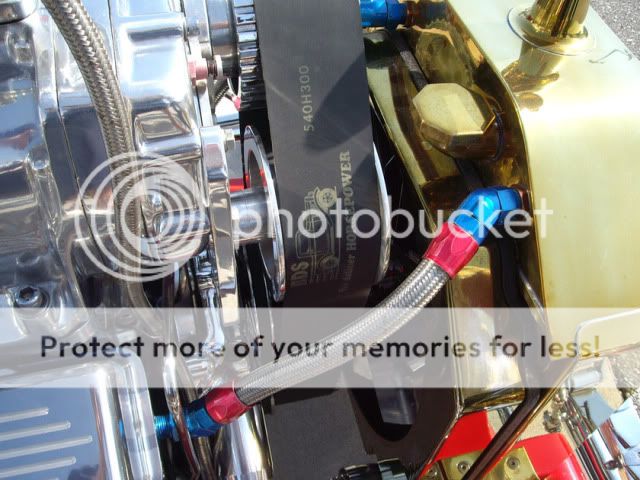
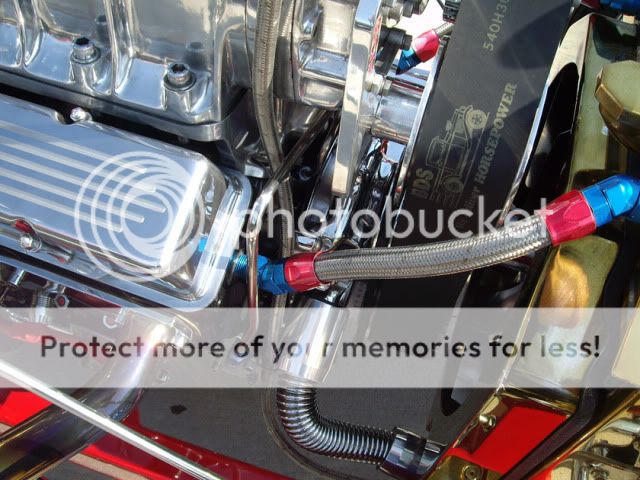
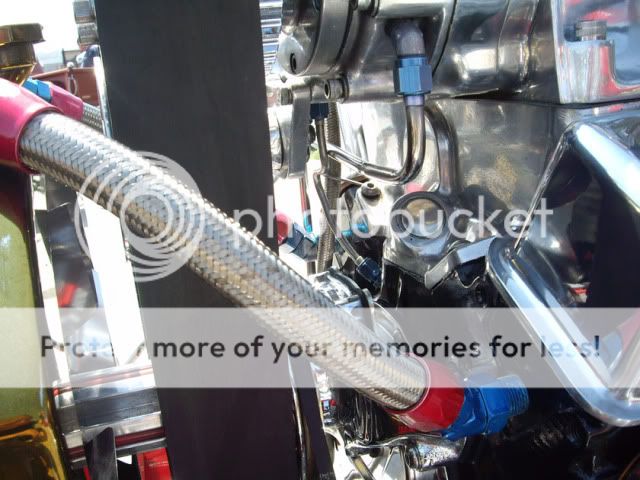




fordsbyjay
Active Member
I am amazed at how small the lines are.
Thanks, Bill, great pics. Confirms my idea of fittings screwed straight into head. And note the hard line from the blower to the fuel pump blockoff plate, probably to get oil vapor to lube blower gears. And there is another hard line from the water pump, but I can't figure it out. Someone did a nice detail job on that motor.
Jay, I use #10 lines on mine.
Jay, I use #10 lines on mine.
Bill Pedersen
Member
Here are a few more pictures that should answer the questions. The braided line is a fuel line that goes down to the frame.
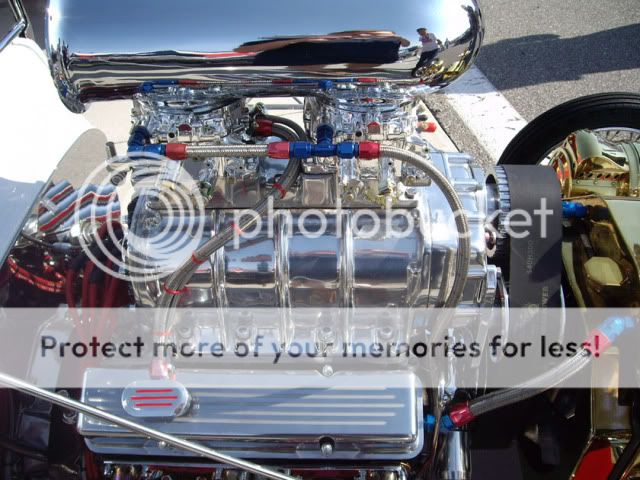
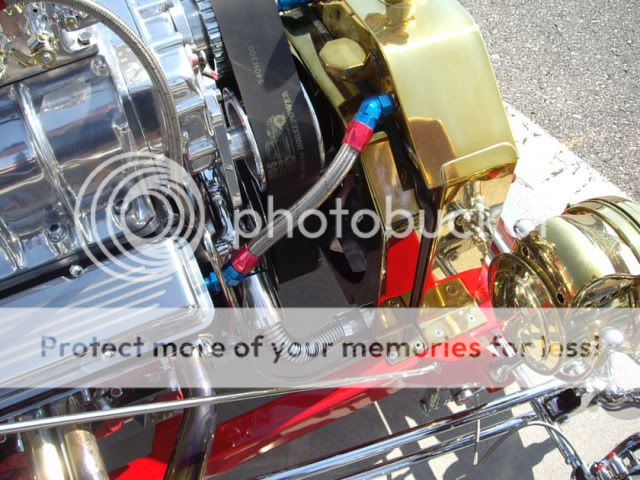

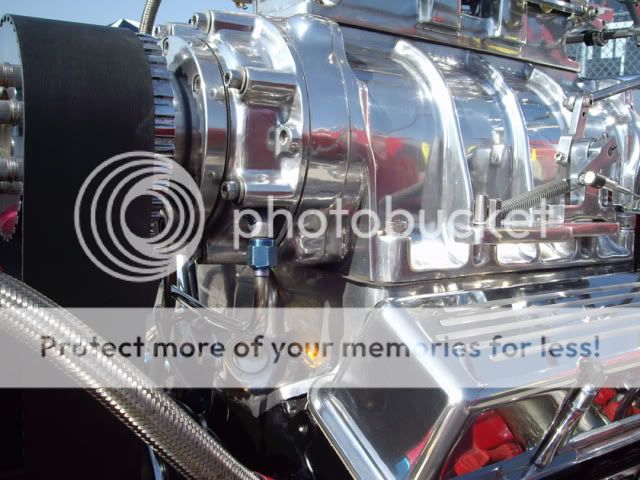
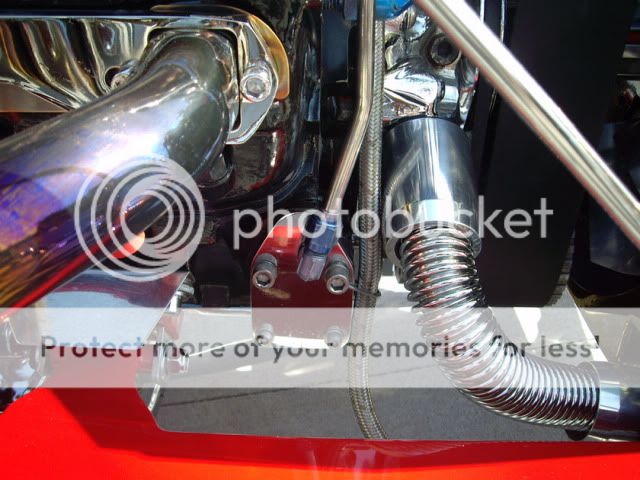
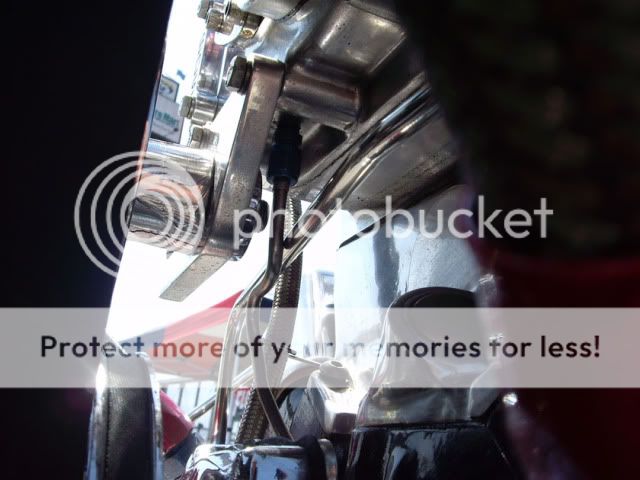






one finger john
Active Member
Bill, I thought the blower end plate bearings were sealed units that had a specific amount of 90 wt.? Could be wrong. If the hard line is a drain to the fuel pump plate, where is the pressurized oil coming from?
John
John
Bill Pedersen
Member
Great pics, Bill! I think you liked this car.
Yes, I did like this car and I took a lot of pictures.
On any blower I’ve run, I’ve anyways used a self-contained setup using about 16oz of 80w-90w gear lube. This setup looks like it would only use the engine oil. I wonder if gears hold up without any wear issues. There are 2 hard lines. I would assume that one is supply and the other is the return.
Lee_in_KC
Active Member
On the stock installation of Jimmy blowers (Deisel engines) the drive gears are lubed with pressurized engine oil. What you are seeing here is an adaption of the original set-up to a V8. It looks like he has tapped into the the front of the main oil galley of the block to feed the blower. There is typically a 1/4" pipe plug at that spot, but I have seen guys drill it out to a larger size and tap it for an AN fitting. Then they run a line back to the tap just above the oil filter boss. This supposedly helps with getting oil to the front of the motor in hi-po applications. The set-ups I have seen were on circle-track cars.
The line you see coming out of the driver's side on the blower front plate and going down to the fuel pump pad cover is to drain the oil from the blower back to the pan.
The line you see coming out of the driver's side on the blower front plate and going down to the fuel pump pad cover is to drain the oil from the blower back to the pan.
old round fart
Well-Known Member
On the car I built in 1971, I used a race blower manifold with no provision for water out. I drilled and tapped the head with a 3/4 pipe and fed the radiator with 2 1" pipes. I also had a short 3/4 nipple welded to that nipple with a water temp. gauge for each head.
Screaming Metal
Active Member
Yes, I did like this car and I took a lot of pictures.
On any blower I’ve run, I’ve anyways used a self-contained setup using about 16oz of 80w-90w gear lube. This setup looks like it would only use the engine oil. I wonder if gears hold up without any wear issues. There are 2 hard lines. I would assume that one is supply and the other is the return.
Yes...you can run oil lines directly to the end plates and have it step to take oil in and then return it to the pan. In a ideal world, this is a ideal solution.
I prefer to set mine up with oil, fresh oil hitting those races and all, but thats just me and all. The majority of the setups run a oil bath in the front and rear covers. Some people say you don't do that, if its gotta bearing, you gotta lube it, I don't give a flyin flip what its made out of.
Usually I drill and tap a small hole at about the 1 o'clock position on the endplate, front and rear, to fill the covers. I then make a dipstick, that I can check the level in the covers.You want the oil to ride up on the bears to just below the shaft. That way, the bearing, endplate clearence, gears and all have adequate lubrication.
And Yes, for the racers, theres a setup for the big boys that turn 10,000rpm+ on their motors. Essentially, its a special dry setup. At those blower speeds, the bearing is spinning so fast, the oil can't get to the bearings or the races. And yes....you can pressure lube them also. On the older setups....we do just that. 80/90 gear oil is what you normally use, but it depends on your seals in your endplates....
Screaming Metal
Active Member
Yes, I did like this car and I took a lot of pictures.
On any blower I’ve run, I’ve anyways used a self-contained setup using about 16oz of 80w-90w gear lube. This setup looks like it would only use the engine oil. I wonder if gears hold up without any wear issues. There are 2 hard lines. I would assume that one is supply and the other is the return.
Yes...you can run oil lines directly to the end plates and have it step to take oil in and then return it to the pan. In a ideal world, this is a ideal solution.
I prefer to set mine up with oil, fresh oil hitting those races and all, but thats just me and all. The majority of the setups run a oil bath in the front and rear covers. Some people say you don't do that, if its gotta bearing, you gotta lube it, I don't give a flyin flip what its made out of.
Usually I drill and tap a small hole at about the 1 o'clock position on the endplate, front and rear, to fill the covers. I then make a dipstick, that I can check the level in the covers.You want the oil to ride up on the bears to just below the shaft. That way, the bearing, endplate clearence, gears and all have adequate lubrication.
And Yes, for the racers, theres a setup for the big boys that turn 10,000rpm+ on their motors. Essentially, its a special dry setup. At those blower speeds, the bearing is spinning so fast, the oil can't get to the bearings or the races. And yes....you can pressure lube them also. On the older setups....we do just that. 80/90 gear oil is what you normally use, but it depends on your seals in your endplates....
Similar threads
- Replies
- 9
- Views
- 5K



